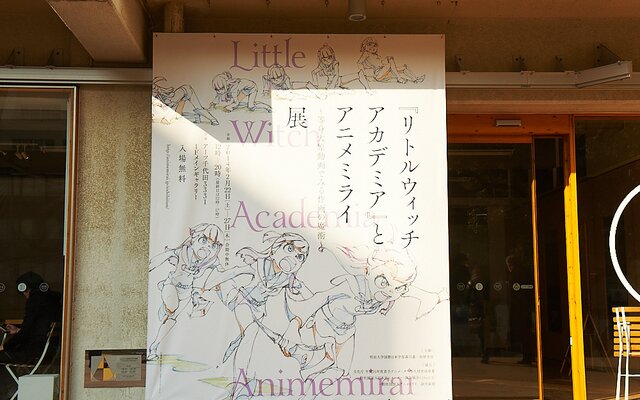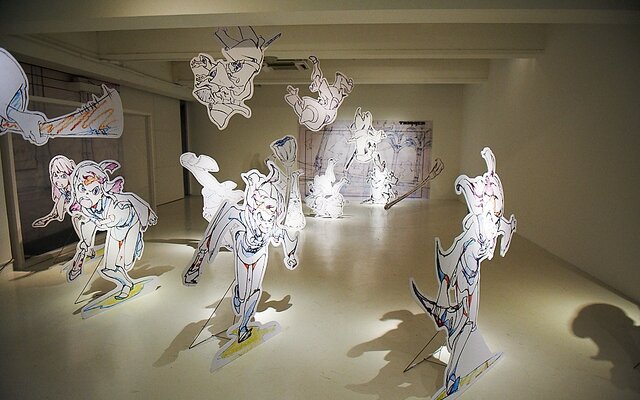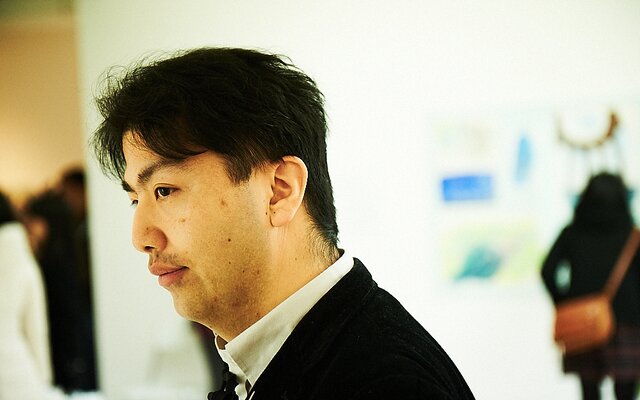Little Witch Academia is an animated short produced last year as part of the young animator training project “Anime mirai” that has gained attention for its level of quality. In just shy of 25 minutes, the short follows Akko, a girl who dreams of becoming a witch, as she enters a school for magic and defeats an old dragon with the help of her classmates. It was produced by the studio Trigger, well-known for its TV anime Kill la Kill. Upon being released for a limited run on YouTube, it drew comments from around the world requesting a sequel. They successfully raised money for a sequel through crowdfunding, surpassing 150,000 dollars in five hours and 620,000 dollars in one month. The exhibit for this noteworthy anime was held for six days in Arts Chiyoda 3331, an art center reasonably close to Akihabara, and featured key frame drawings (genga) blown-up into life-sized sequential panels which inventively reproduced animated motion in real space. The venue was packed not only with fans of the title, but also visitors with an interest production drawings of animation.

For this piece, we spoke with the exhibit organizer Kaichiro Morikawa, Associate Professor in the School of Global Japanese Studies at Meiji University who is also involved in the enormous Tokyo International Manga Museum (name tentative) 1 project, planned to hold the world’s largest collection of manga, anime, and games.
Professor Morikawa started his career as a scholar of architecture. Focusing on the shift of Akihabara as an electronics town to an otaku town, in 2003 he published Learning from Akihabara: The Birth of a Personapolis, which explored Akihabara’s distinctive character from an architecture standpoint. It received high praise all around. In the following year, he worked as the commissioner for the Japan pavilion at the Venice Biennale 9th International Architecture Exhibition, and put together an exhibit entitled “Otaku: Personality=Space=City.” This exhibit received the Free Genre Seiun Award at the 44th Japan Science Fiction Convention. Professor Morikawa is a self-described otaku.
This exhibit came about when a representative from the Anime mirai project 2 saw an exhibit put on by Professor Morikawa in March 2013 of anime “Puella Magi Madoka Magica” which incorporated his method of life-size represention, and approached him about doing one for the project’s anime.
Professor Morikawa reflected back on that time. “When we first took [the exhibit] on, the vision was something cozier in size. However, as we moved forward, we went with the main gallery of 3331 as the venue, and I was faced with the challenge of effectively using such a large space.”
The main gallery at the art center Arts Chiyoda 3331 is a white space approximately 475 square meters in size. An artwork exhibit for the work of director Katsuhiro Ōtomo, famous for his feature length anime film Akira, was also held here.
Arts Chiyoda 3331 is a renovation of a school building, and the main gallery is a long hallway-like space spanning 34 meters. Regarding the space, Professor Morikawa explained, “If we made use of this length, we could let the visitors experience the distance the main character Akko runs in the climax with life-sized drawings. In a way, we could plot the movement in the anime to real space, and, in turn warp the visitors into anime-dimension. We designed the entire exhibit around this central idea.”



The wide openness of the venue allowed viewers to enjoy the displays from any point. The space was used particularly well to convey the dynamic movement found in anime. Upon entering the venue, visitors were greeted by an installation of several life-size panels arranged three-dimensionally of blown-up key frame drawings depicting Akko beginning her run. “My aim was to have the guests see from the beginning that the focus of the exhibit was not on the individual drawings, but rather the ‘movement’ woven by the drawings,” explained Professor Morikawa. In addition to this, a sequence of panels depicting Akko falling from a broom were displayed mid-air. It’s a scene from the anime where she crashes while being chased by a dragon. This leads to the aforementioned scene following the long wall. With the precious witch’s rod “Shiny Rod” in hand, Akko runs to take back the magic stone from the ancient dragon and is just about to take it as she slips. It was a heart-pounding installation.





There was a reason for using production drawing done in pencil instead of completed colored images.
“Promotions using life-size panels of anime and bishoujo games are everywhere in Akihabara. Since they need to catch the eye, naturally there are a lot of bishoujo in set poses done in flashy colors. Also, if you go to a theme park like Disneyland, there are life-size animatronics and costumed actors. I think people are accustomed to seeing that sort of thing. But key frame drawings are sequential images which compose animated motion within the realm of the film. By blowing up the artwork to life-size proportions and arranging them sequentially, as well as emphasizing the pencil strokes of the animators, it is effective in getting the viewer to really feel the action of the animation.

Professor Morikawa admits to being an otaku. He expressed his high opinion of Little Witch Academia, stating, “Even though it’s a short that’s only 25 minutes, after you finish watching, you feel as though you’ve seen something twice as long.” It is certainly this appreciation for the work that fueled his dedication to the project.

You may be wondering why an associate professor at a university would be putting on this kind of event.
“I’ve been designing exhibitions since I was in the architecture field. Since I also research the transformation of Akihabara, I’ve become involved in exhibits of otaku culture.”
In 2004, Professor Morikawa put together an exhibit entitled “Otaku: Personality=Space=City” at the Venice Biennale International Architecture Exhibition. He brought Akihabara and Japanese subculture to the City of Water.
“I determined that the tastes of architects and designers are too different from otaku culture to be able to create it, so partnered with creators of otaku culture working in Akihabara to put the exhibit together. From doing the exhibit in Venice, the focus of my research went from the city of Akihabara to what’s inside it, that is, to otaku culture.”
Professor Morikawa added that this led to his latest exhibit. He had a calm way of speaking and chose each word carefully.

Finally, I asked if it was difficult working on a separate project while still in the midst of the large Tokyo International Manga Museum project.
“Actually, holding this exhibit is one step towards establishing the manga, anime, and game museum. The Yoshihiro Yonezawa Memorial Library at Meiji University has been doing more of this kind of programming, such as exhibits related to Puella Magi Madoka Magica and Hatsune Miku. In addition to building a methodology for presenting on anime and manga, it’s also forming a consensus on addressing this field at the university. I’d really like this museum to become a reality soon,” he enthusiastically replied.

Professor Morikawa takes on projects and events aimed at otaku. There is much to be expected from his next plan!
^1^ A manga, anime, and game joint archive and museum planned by Meiji University in Tokyo. It’s expected to have over 2 million materials, including original manga and anime art, arcade game machines and PCBs, fan doujinshi, figurines, models, and other related items. Its forerunning facility, the Yoshihiro Yonezawa Memorial Library, opened in 2009.
^2^ A project organized by the Japan Agency for Cultural Affairs to support the training of young animators. The titles produced through the project are released in theaters, broadcast on TV, or streamed online.
© TRIGGER
This is a Tokyo Otaku Mode original article.

 Shopping Guide
Shopping Guide





































